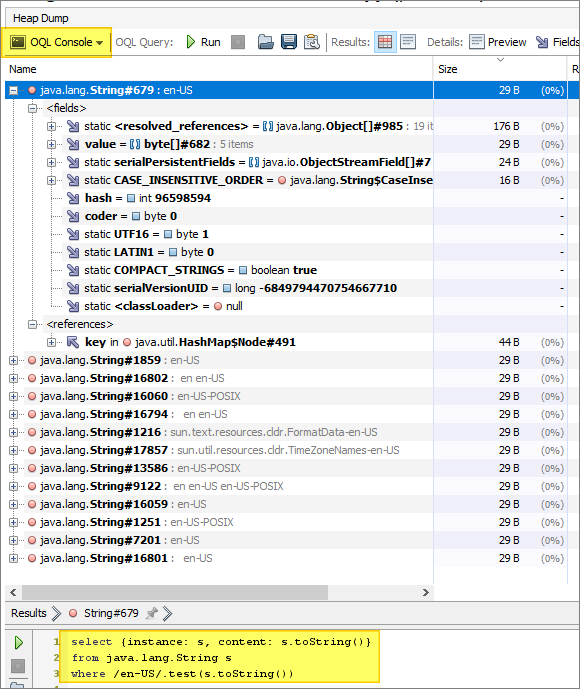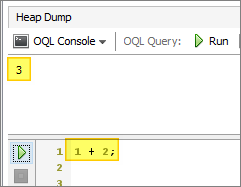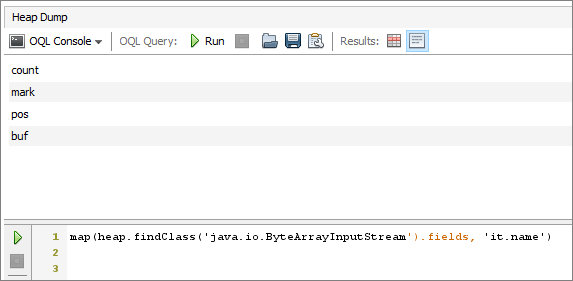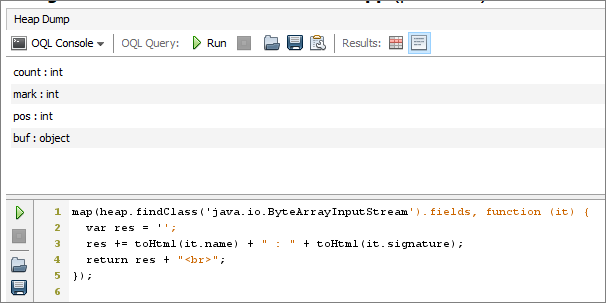JVM Heap Dumps and OQL
VisualVM is a great tool for exploring Java applications and the JVM in which they are running. One area which has always been a bit overwhelming (to me) is the heap dump - a mass of raw information for millions of objects, which can be hard (for me) to sift through.
OQL (Object Query Language), a tool which is included in the heap analyzer, allows you to filter heap data in a variety of ways.
As the help pages explain, OQL is based on JavaScript expression language, and includes a set of built-in objects and functions. An expression is a JavaScript fragment which produces a value.
By combining these objects and functions with JavaScript expressions, you can write and execute complex queries against your heap data. The help page (referenced above) contains lots of examples - but I will show some specific ones below.
Here is a simple example to get us started:
And here is the query from the above example:
|
|
The above query uses two expressions. The select clause contains an expression which creates a JavaScript object literal. The object defines two properties - instance and content:
{instance: s, content: s.toString()}
The above expression refers to a variable (s) which is defined in the from clause:
java.lang.String s
Finally, the where clause consists of a JavaScript test() expression - which returns true or false. This is our filter - just like a SQL where clause.
The end result is a query which returns all String objects containing “en-US”. (This example uses a regular expression, so the text we’re searching for can be a substring.)
OQL queries can be plain JavaScript expressions - you don’t have to use the OQL “select…” syntax:
The semicolon at the end of the expression is optional.
Here is a more interesting example:
The above example could also have been written using the select keyword (a select statement which does not use a from clause or a where clause):
select map(heap.findClass('java.io.ByteArrayInputStream').fields, 'it.name')
What does the above query do, and how does it work?
It uses the OQL map() function, which takes two parameters:
- an array (or iterable)
- an expression string (or a callback function)
The array is created by using the fields property of another built-in OQL function - the heap.findClass() function. This returns an array of (non-static) fields for the specified class.
The expression string is indeed a string representing a JavaScript expression. In the above example, the expression refers to “it” which is a built-in variable of the map() function, representing the current element in the array over which map() iterates.
Each element in our array is a field object - and each OQL field object has two properties: name and signature. In our example, we access the name property using the expression string it.name.
The end result is a list of the four fields (count, mark, pos, and buf) of the ByteArrayInputStream class.
Taking this one step further, I mentioned above that map() takes an expression string or a callback function. Here is that same example again, but this time using a callback instead of an expression string:
|
|
In the above example, we access both properties of the field object - name and signature. We also use the OQL toHtml() function to build our results.
The output looks like this:
One more example:
|
|
This sorts a list of URI objects by their string values.
There are several more advanced examples of OQL statements in the help page - and even more on the web (Stack Overflow is a good source).




